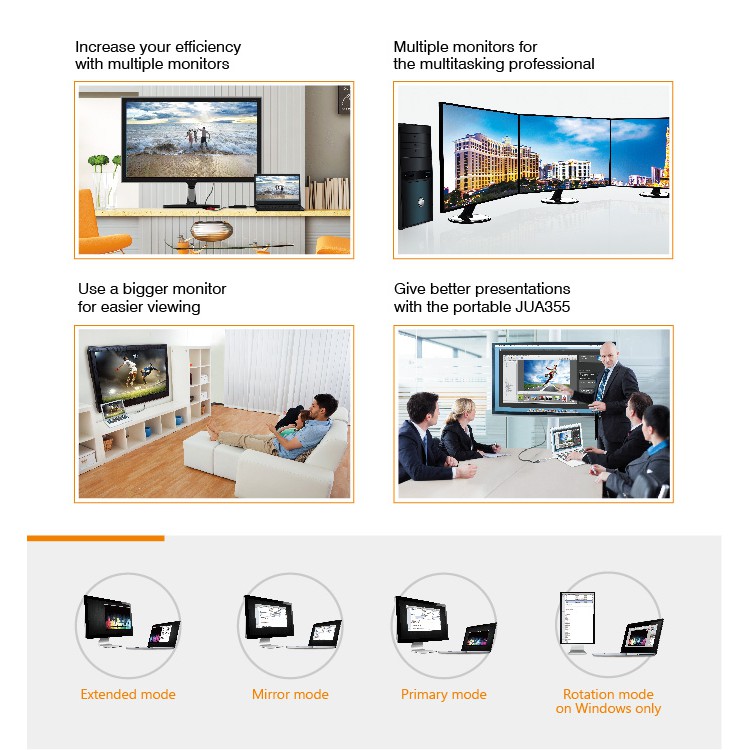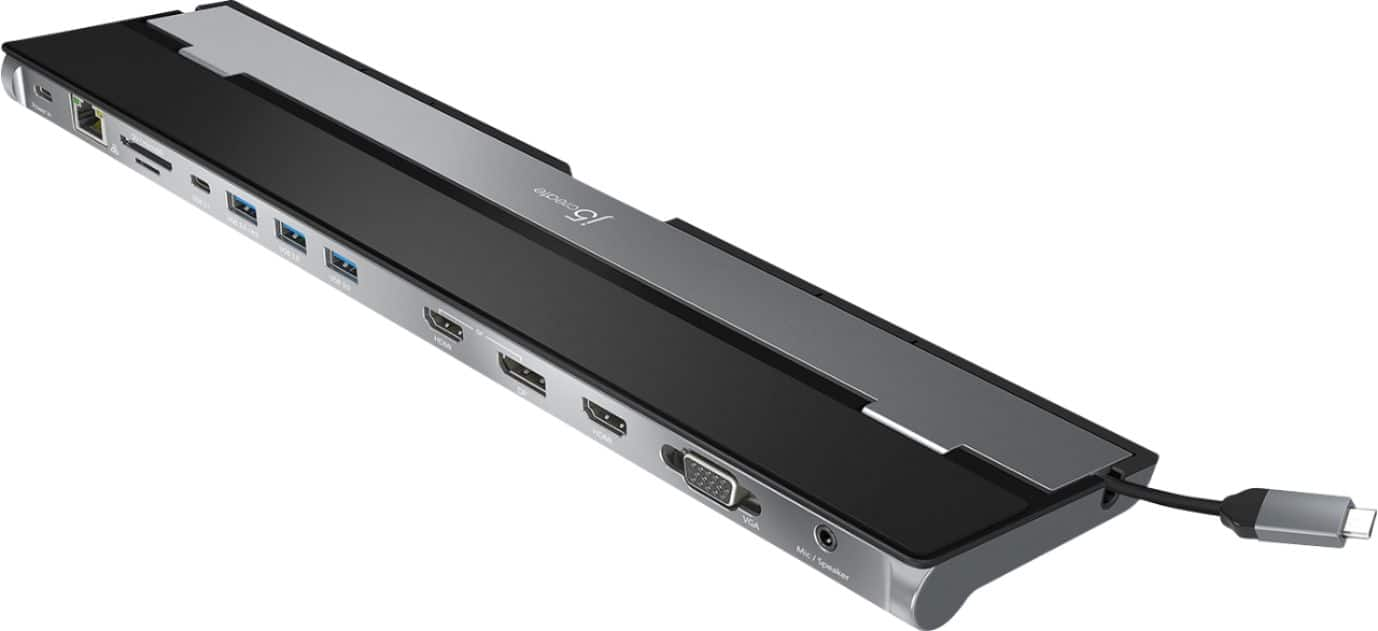For on the go or stationary use the j5create has 2 Thunderbolt ports (male) that plug into the side of a MacBookPro replicating the 2 Thunderbolt ports of the Mac and adding 2 USB3, 2 cardslots (which I have not used) and an HDMI port (full-size) on the back of the product. WARRANTY OF j5 create j5 create offers a limited 1-year warranty. User’s wear & tear damage are not included. The user shall call or email j5 create customer service with defect information of the product and obtain a return authorization number. Users are responsible for one way return freight cost and we will take care of one way freight back. Please make sure your network is available and Do Not unplug the Wormhole during the driver update. Remove the Wormhole cable from the slave computer. Select “Online Update” 4. After you have finished the installation process, re-plug the Wormhole device into both computers. O About the Wormhole Switch.
One of the ways to connect your Mac to an external display is by using a High-Definition Multimedia Interface or HDMI cable. You can connect the HDMI cable to the HDMI port on your Mac to a second monitor or TV. Whether you want to use a second screen or you want to export full audio and video display on your TV, connecting your devices is a lot easier with HDMI. Some Mac models, such as the Mac mini, also rely on HDMI to connect the computer to the display.
But with the release of macOS Catalina, a lot of Mac users using HDMI connection reported encountering various problems after the upgrade. Several users reported getting a black screen after installing the new version of macOS, even with the monitor still turned on. The display just turns black (or dark green in some cases) and eventually shuts down.
Other users, on the other hand, got a No Signal error message instead of the black screen. There are also some cases where the external display just blinks randomly when connected to a Mac running macOS Catalina.
Mac users who are using HDMI for their second monitor are less affected compared to Mac mini users who use HDMI as their main connection. However, this doesn’t deny the fact that display problems such as these can cause a lot of inconvenience and annoyance.

This guide will show you what to do if your Mac shows no HDMI signal after Catalina update.

How to Fix HDMI Signal After Catalina Update
There is no explanation yet why the macOS Catalina update caused the HDMI to stop working, and it will probably take a while for Apple to release an update that addresses this issue. If you’re using your Mac for study or work, finding a solution to this problem is a priority because you can’t do anything with a black screen.
Before you try the solutions listed below, try some of these emergency steps first to see if they work.
- Restart your Mac. If you’re in the middle of installation, cancel it first before restarting. Once your Mac has restarted, resume the upgrade and see if you encounter further issues.
- Make sure that the HDMI and power cables are connected properly.
- Use a different HDMI cable. In the case that your HDMI cable is damaged, replacing it with a new one should resolve the issue.
- Use a different port. Try to use a different cable to connect your Mac to your display, if possible. For example, you can use a USB-C to HDMI cable for some Mac models.
- Optimize your Mac using Outbyte MacRepair to delete possible corrupted files causing the issue.
If the above steps don’t work, try the solutions below.
1. Restart Your Display.
Restarting your TV, external monitor, or other HDMI devices should be your first step in fixing this issue. To do this:
- Turn off your HDMI display while your Mac is turned on.
- Disconnect the HDMI cable from your Mac, then plug it back again.
- Turn on your HDMI display again.
If the problem is caused by a minor glitch, restarting your HDMI device should do the trick. If not, try the other fixes below.
2. Enable Your Display Driver.
If you’re using an HDMI monitor or a TV as an external display and you encounter the black screen issue, changing your Mac’s privacy settings should take care of the issue. To do this:
- Click on the Apple logo, then choose System Preferences.
- Click on Security & Privacy, then click Screen Recording from the left menu.
- Tick off Enable the Display Driver in the right panel.
Changing your screen resolution and refresh rate parameters should help. Go to the Apple menu > System Preferences > Display and choose the resolution that you want.
3. Turn Off the HDMI Ultra HD Color Feature
HDMI Deep Color is responsible for creating a more realistic and smooth rendering of an image on the screen. However, there have been reports that this feature causes flickering and other screen problems when turned on. So if your external display has this feature, try turning off to see if the problem goes away.
4. Reset Your Mac’s SMC.
The System Management Controller or SMC manages a lot of aspects of your Mac, including the display. So if you’re having screen issues, such as the HDMI not working on Mac after Catalina update, resetting the SMC might help.
To reset the SMC, follow the steps below.

- Shut down your Mac.
- Hold the left Shift + Control + Option keys together, then press and hold the Power button down.
- Wait for 10 seconds, then let go.
- Turn on your Mac again.
If you’re using an iMac or a Mac Mini, here are the steps to reset the SMC:
- Shut down your device.
- Unplug the power cable.
- Wait for at least 15 seconds.
- Plug the power cable back in.
- Turn on your Mac.
Once your Mac’s SMC has been reset, check if you’re still getting screen problems on macOS Catalina.
5. Reset NVRAM.
If resetting the SMC does not fix your problem, you should try resetting the NVRAM this time. To do this:
- Shut down your Mac.
- Turn it back on, then immediately press and hold this key combination: Option + Command + P + R.
- Wait for at least 20 seconds, during which your device might appear to restart.
- Release the keys when you hear the second startup sound or when you see the Apple logo appear and disappear for the second time.
Summary
The release of macOS Catalina has also introduced a lot of bugs and issues that Apple needs to fix, including the HDMI signal problem on external displays. Rolling back to macOS Mojave is not an option because this method does not fix the issue, according to user reports. So instead of waiting for an official fix from Apple, you might want to give the methods above a try.
See more information about Outbyte and uninstall instructions. Please review EULA and Privacy Policy.
I've tried submitting a ticket which they never replied to. I have a j5 create hdmi to USB adapter and the model is JUA254. I got this to be able to watch Netflix from my laptop and display is on my tv. When I bring up Netflix it doesn't play and the Netflix screen turns green. Has anyone else had this problem?
J5 Create Not Detecting Monitor
I have a Mac air and have installed the correct software according to the instructions.
JUA254 needs USB 3.0 port. Does your Mac Air have one to use for it? If not, did you try lowering the resolution of the TV from 1080p to 720p or?
One site for Apple says the Air has USB 3.0 and HDMI. Why don't you use that? Why have a cable if your TV is wireless or wired network smart TV? You could cast to it from the Mac Air.
To connect a MacBook Air to an external display (including a TV) your best bet is a Thunderbolt/Mini DisplayPort to HDMI adapter. You'll generally get better results than a USB to HDMI converter.

Very thorough discussion
- Wireless Adapter Kali Linux not working? I have Kali Linux installed on Virtual box on a 2018 macbook pro. I have a TP-LINK WN722N wireless adapter plugged in through a Rankie USB C adapter. The adapter works perfectly on the host computer and I have the necessary driver installed on host. Whenever I power on Kali Linux from Virtual box the adapter immediately turns off and turns on again when I close Kali. How can I fix this?
- Apple USB C to USB adapter Just bought a MacBook Pro and got the usb c to USB adapter but my usbs won't fit into it? Even tried my iPhone cable and it wouldn't fit. Is there a trick to this? I didn't want to break it since I just bought it and might have to return it
- USB C, to USB A, to HDMI? I'm trying to hook up my macbook pro to my tv so I can use it as a monitor. The output from the macbook is a usb c port, connected to an adapter which converts it to USB A, then another adapter converts that usb a signal into a usb c signal which leads to an hdmi cable. Kind of confusing i know, but is there any way to do this?
- MacBookPro Won't Connect to LG Tv Through HDMI Cable? My MacBook pro is not connecting the my LG tv.it says no signal. And when i connect it to tv it keeps blinking. Macbook pro all upto date. Hdmi cable is fine. My MacBook connect the other Tv's at home with same hdmi cable with no problem.whay can't i connect the LG tv?